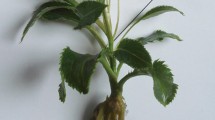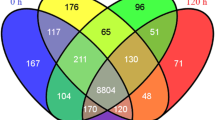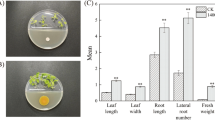Abstract
Strain 39 is an endophytic fungus which was isolated from Dioscorea nipponica Makino (DNM). After Strain 39 co-cultured with ethanol extract of DNM rhizomes for several days, the content of saponins in this culture mixture would be obviously increased. To analyze the mechanism of this microbial transformation, we used the differential display reverse transcription polymerase chain reaction (DDRT-PCR) method to compare the transcriptomes between Strain 39 cultured in normal PD medium and in PD medium which added ethanol extract of DNM rhizomes. We amplified 29 DDRT-PCR bands using 12 primer combinations of three anchored primers and five random primers, and six bands were re-amplified. Analysis of real-time PCR and sequence alignment showed that three clones were up-regulated in sample group: squalene epoxidase, squalene synthase, and catalase, one clone was expressed only in sample group. The possible roles and origins of the above genes were discussed, and the molecular mechanism of Strain 39 biotransformation was speculated. This study is the first report of the molecular biotransformation mechanism of saponins production by endophytic fungus of DNM.


Similar content being viewed by others
References
Oncina R, Botía JM, Del Río JA, Ortuño A (2000) Bioproduction of diosgenin in callus cultures of Trigonella foenumgraecum L. Food Chem 70:489–492. doi:10.1016/S0308-8146(00)00121-7
Wang FQ, Li B, Wang W, Zhang CG, Wei DZ (2007) Biotransformation of diosgenin to nuatigenin-type steroid by a newly isolated strain, Streptomyces virginiae IBL-14. Appl Microbiol Biotechnol 77:771–777. doi:10.1007/s00253-007-1216-1
Bertranda J, Liagreb B, Bégaud-Grimaudc G, Jauberteaua MO, Beneytoutb JL, Cardot PJP, Battuc S (2009) Analysis of relationship between cell cycle stage and apoptosis induction in K562 cells by sedimentation field-flow fractionation. J Chromatogr B 877:1155–1161. doi:10.1016/j.jchromb.2009.02.064
Liagre B, Vergne-Salle P, Corbiere C, Charissoux JL, Beneytout JL (2004) Diosgenin, a plant steroid, induces apoptosis in human rheumatoid arthritis synoviocytes with cyclooxygenase-2 overexpression. Arthritis Res Ther 6:R373–R383. doi:10.1186/ar1199
Jayachandran KS, Vasanthi HR, Rajamanickam GV (2009) Antilipoperoxidative and membrane stabilizing effect of diosgenin, in experimentally induced myocardial infarction. Mol Cell Biochem 327:203–210. doi:10.1007/s11010-009-0058-9
Peng Y, Wang YX, Yang ZH, Bao JG, Peng HX (2010) Content increase of spirostanol saponins during enzymatic hydrolysis of Dioscorea zingiberensis C. H. Wright. Ind Eng Chem Res 49:8279–8281. doi:10.1021/ie1001923
Liu L, Dong YS, Qi SS, Wang H, Xiu ZL (2010) Biotransformation of steriodal saponins in Dioscorea zingiberensis C. H. Wright to diosgenin by Trichoderma harzianum. Appl Microbiol Biotechnol 85:933–940. doi:10.1007/s00253-009-2098-1
Zhu YL, Huang W, Ni JR, Liu W, Li H (2010) Production of diosgenin from Dioscorea zingiberensis tubers through enzymatic saccharification and microbial transformation. Appl Microbiol Biotechnol 85:1409–1416. doi:10.1007/s00253-009-2200-8
Yin CH, Li PQ, Li HJ, Xu LJ, Zhao JL, Shan TJ, Zhou LG (2011) Enhancement of diosgenin production in Dioscorea zingiberensis seedling and cell cultures by beauvericin from the endophytic fungus Fusarium redolens Dzf2. J Med Plants Res 5:6550–6554. doi:10.5897/JMPR11.921
Li PQ, Lou JF, Mou Y, Sun WB, Shan TJ, Zhou LG (2012) Effects of oligosaccharide elicitors from endophytic Fusarium oxysporum Dzf17 on diosgenin accumulation in Dioscorea zingiberensis seedling cultures. J Med Plants Res 6:5128–5134. doi:10.5897/JMPR12.120
Abdou R, Scherlach K, Dahse HM, Sattler I, Hertweck C (2010) Botryorhodines A-D, antifungal and cytotoxic depsidones from Botryosphaeria rhodina, an endophyte of the medicinal plant Bidens pilosa. Phytochemistry 71:110–116. doi:10.1016/j.phytochem.2009.09.024
Kusari S, Zühlke S, Spiteller M (2009) An endophytic fungus from Camptotheca acuminata that produces camptothecin and analogues. J Nat Prod 72:2–7. doi:10.1021/np800455b
Wang LW, Xu BG, Wang JY, Su ZZ, Lin FC, Zhang CL, Kubicek CP (2012) Bioactive metabolites from Phoma species, an endophytic fungus from the Chinese medicinal plant Arisaema erubescens. Appl Microbiol Biotechnol 93:1231–1239. doi:10.1007/s00253-011-3472-3
Wang YM, Chen HZ (2011) Isolation and identification of a camptothecin-producing endophytic fungus from Camptotheca acuminate. Microbiol China 38:884–888
Liang P, Pardee AB (1992) Differential display of eukaryotic messenger RNA by means of the polymerase chain reaction. Science 257:967–971. doi:10.1126/science.1354393
Li B, Tang M, Tang K, Zhao L, Guo S (2012) Screening for differentially expressed genes in Anoectochilus roxburghii (Orchidaceae) during symbiosis with the mycorrhizal fungus Epulorhiza sp. Sci China Life Sci 55:164–171. doi:10.1007/s11427-012-4284-0
Muellenborn C, Krause JH, Cerboncini C (2011) Analysis of differential transcript expression reveals time-dependent leaf responses to Sclerotinia sclerotiorum in wild and cultivated sunflower. Plant Mol Biol Rep 29:597–608. doi:10.1007/s11105-010-0265-2
Unver T, Bozkurt O, Akkaya MS (2008) Identification of differentially expressed transcripts from leaves of the boron tolerant plant Gypsophila perfoliata L. Plant Cell Rep 27:1411–1422. doi:10.1007/s00299-008-0560-7
Elabed H, Maatallah M, Hamza R, Chakroun I, Bakhrouf A, Gaddour K (2013) Effect of long-term starvation in salty microcosm on biofilm formation and motility in Pseudomonas aeruginosa. World J Microbiol Biotechnol 29:657–665. doi:10.1007/s11274-012-1221-0
Mehrabi-Koushki M, Rouhani H, Mahdikhani-Moghaddam E (2012) Differential display of abundantly expressed genes of Trichoderma harzianum during colonization of tomato-germinating seeds and roots. Curr Microbiol 65:524–533. doi:10.1007/s00284-012-0189-1
Du XW, Mou JC, Meng FJ, Liu Y, Li B, Yu D, Wu JK, Zhang Y (2013) Increase of diosgenin in Dioscoreae Nippponicae Rhizoma with solid state fermentation of endophytic fungi. Drugs Clin 28:179–181
Livak KJ, Schmittgen TD (2001) Analysis of relative gene expression data using real-time quantitative PCR and the 2 2(-Delta Delta CT) method. Methods 25:402–408. doi:10.1006/meth.1262
Popják G, Agnew WS (1979) Squalene synthetase. Mol Cell Biochem 27:97–116. doi:10.1007/BF00218354
Abe I, Rohmer M, Prestwich GD (1993) Enzymatic cyclization of squalene and oxidosqualene to sterols and triterpenes. Chem Rev 93:2189–2206. doi:10.1021/cr00022a009
Zhao MW, Liang WQ, Zhang DB, Wang N, Wang CG, Pan YJ (2007) Cloning and characterization of squalene synthase (SQS) gene from Ganoderma lucidum. J Microbiol Biotechnol 17:1106–1112
Seo JW, Jeong JH, Shin CG, Lo SC, Han SS, Yu KW, Harada E, Han JY, Choi YE (2005) Overexpression of squalene synthase in Eleutherococcus senticosus increases phytosterol and triterpene accumulation. Phytochemistry 66:869–877. doi:10.1016/j.phytochem.2005.02.016
Gupta N, Sharma P, Santosh Kumar RJ, Vishwakarma RK, Khan BM (2012) Functional characterization and differential expression studies of squalene synthase from Withania somnifera. Mol Biol Rep 39:8803–8812. doi:10.1007/s11033-012-1743-49
Lee MH, Jeong JH, Seo JW, Shin CG, Kim YS, In JG, Yang DC, Yi JS, Choi YE (2004) Enhanced triterpene and phytosterol biosynthesis in Panax ginseng overexpressing squalene synthase gene. Plant Cell Physiol 45:976–984. doi:10.1093/pcp/pch126
Merkulov S, van Assema F, Springer J, Fernandez Del Carmen A, Mooibroek H (2000) Cloning and characterization of the Yarrowia lipolytica squalene synthase (SQS1) gene and functional complementation of the Saccharomyces cerevisiae erg9 mutation. Yeast 16:197–206
Gokhale VM, Kulkarni VM (1999) Comparative molecular field analysis of fungal squalene epoxidase inhibitors. J Med Chem 42:5348–5358. doi:10.1021/jm9806852
Han JY, In JG, Kwon YS, Choi YE (2010) Regulation of ginsenoside and phytosterol biosynthesis by RNA interferences of squalene epoxidase gene in Panax ginseng. Phytochemistry 71:36–46. doi:10.1016/j.phytochem.2009.09.031
Liu W, May GS, Kontoyiannis DP, Li RY (2004) Cloning of the Aspergillus fumigatus squalene epoxidase gene. J Peking Univ (Health Sci) 36:476–482. doi:10.3321/j.issn:1671-167X.2004.05.007
Inoue K, Shibuya M, Yamamoto K, Ebizuka Y (1996) Purification and characterization of furostanol glycoside 26-O-beta-glucosidase from Costus speciosus rhizomes. FEBS Lett 378:157–160. doi:10.1016/0014-5793(95)01447-0
Inoue K, Shibuya M, Yamamoto K, Ebizuka Y (1996) Molecular cloning and bacterial expression of a cDNA encoding furostanol glycoside 26-O-beta-glucosidase of Costus speciosus. FEBS Lett 389:273–277. doi:10.1016/0014-5793(96)00601-1
Arthan D, Kittakoop P, Esen A, Svasti J (2006) Furostanol glycoside 26-O-beta-glucosidase from the leaves of Solanum torvum. Phytochemistry 67:27–33. doi:10.1016/j.phytochem.2005.09.035
Rodriguez RJ, Redman RS, Henson JM (2004) The role of fungal symbioses in the adaptation of plants to high stress environments. Mitig Adapt Strat Glob Change 9:261–272. doi:10.1023/B:MITI.0000029922.31110.97
Bonnet M, Camares O, Veisseire P (2000) Effects of zinc and influence of Acremonium lolii on growth parameters, chlorophyll a fluorescence and antioxidant enzyme activities of ryegrass (Lolium perenne L. cv Apollo). J Exp Bot 51:945–953. doi:10.1093/jexbot/51.346.945
Waqas M, Khan AL, Kamran M, Hamayun M, Kang SM, Kim YH, Lee IJ (2012) Endophytic fungi produce gibberellins and indoleacetic acid and promotes host–plant growth during stress. Molecules 17:10754–10773. doi:10.3390/molecules170910754
Achatz B, Walker F, Baltruschat H et al (2005) The endophytic fungus Piriformospora indica reprograms barley to salt-stress tolerance, disease resistance and higher yield. Proc Natl Acad Sci USA 102:13386–13391. doi:10.1073/pnas.0504423102
Li JL (2005) Studies on the taxol-producing of taxus endophytic fungus. Dissertation, Northeast Agricultural University
Zhao J, Shan T, Mou Y, Zhou L (2011) Plant-derived bioactive compounds produced by endophytic fungi. Mini Rev Med Chem 11:159–168. doi:10.2174/138955711794519492
Acknowledgments
This work was supported by the National Natural Science Foundation of China (Grant Nos. 81274009 and 81373902), Doctoral Education Fund of Ministry (Ph.D. 20112327110003), Open Fund for Key Laboratory Building by Province and Ministry of Heilongjiang University of Chinese Medicine (S201101).
Author information
Authors and Affiliations
Corresponding author
Rights and permissions
About this article
Cite this article
Ding, CH., Du, XW., Xu, Y. et al. Screening for Differentially Expressed Genes in Endophytic Fungus Strain 39 During Co-culture with Herbal Extract of its Host Dioscorea nipponica Makino. Curr Microbiol 69, 517–524 (2014). https://doi.org/10.1007/s00284-014-0615-7
Received:
Accepted:
Published:
Issue Date:
DOI: https://doi.org/10.1007/s00284-014-0615-7




